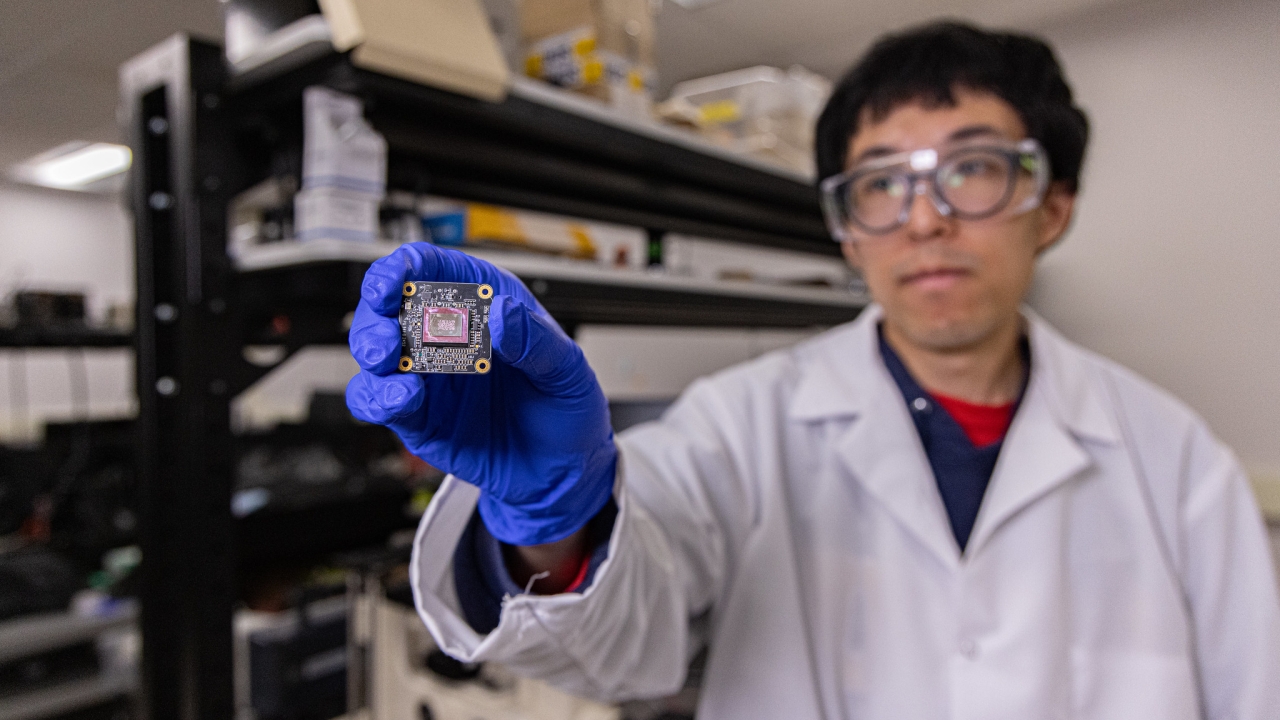Biography: Jerry Woodall
If you can’t imagine life without a TV remote — and if you are under a certain age, you probably can’t — thank Jerry Woodall, who joined the faculty of the UC Davis College of Engineering in July 2012, as a distinguished professor in the Department of Electrical and Computer Engineering, moving from Purdue University.
Woodall invented the high-efficiency red light-emitting diodes (LEDs) used in remote control and data-link applications such as TV sets and the super-bright LEDs used in CD players and short link optical fiber communications. A National Medal of Technology Laureate and a pioneer in the research and development of compound semiconductor materials and devices, Woodall has collected 85 U.S. patents, and his work is cited in more than 350 publications.
 Fully half of the world’s annual sales of compound semiconductor components have been made possible by his research legacy. Other projects include the “pseudomorphic” high electron mobility transistor (HEMT), a state-of-the-art, high-speed device used in cell phones and satellites and the weight-efficient solar cell.
Fully half of the world’s annual sales of compound semiconductor components have been made possible by his research legacy. Other projects include the “pseudomorphic” high electron mobility transistor (HEMT), a state-of-the-art, high-speed device used in cell phones and satellites and the weight-efficient solar cell.
His early career was divided between industry and academia. In 1962, two years after graduating from MIT, he became a junior staff member at IBM’s Watson Research Center in Yorktown Heights. N.Y. Woodall excelled in this environment — referring to this time as “playing in the sandbox” of the IBM labs — and earned 30 consecutive annual IBM Invention Achievement Awards. One of his most significant achievements was the perfection of a process dubbed “liquid-phase epitaxy,” which grew exceptionally pure crystals of gallium arsenide, the semiconductor used to make infrared LEDs. Elsewhere in the scientific world, researcher Herbert Kroemer employed Woodall’s crystal-growing skills in his own work on layered semiconductors. Kroemer’s subsequent Nobel Prize, in 2000, would not have been possible without Woodall’s pioneering efforts.
But that came much later. Woodall also won an $80,000 IBM prize for demonstrating the first prototype heterojunction, an interface between two semiconductor materials that would become crucial in lasers, light-emitting diodes and other devices. He and fellow researcher Harold Hovel used this heterojunction to develop a high-efficiency solar cell that could withstand the punishing environment of outer space; the same material also was used in a transistor that became ubiquitous in cell phones and satellite communication systems.
Somehow, Woodall found time to earn his doctorate in 1982, from Cornell University. He became an IBM fellow three years later: the highest honor accorded an IBM researcher. He was elected to the National Academy of Engineering in 1989, and in 1993 became the Charles William Harrison Distinguished Professor of Microelectronics at Purdue, a position he held until 1998. Yale University made him the C. Baldwin Sawyer Professor of Electrical Engineering in 1999, but Woodall soon returned to Purdue.
President George W. Bush presented Woodall with the National Medal of Technology in 2001. At that point, roughly half the annual $5 billion in sales of gallium arsenide-based semiconductor devices could be traced to his work.
Woodall also has a lighter side, no doubt developed during a childhood that was dominated by his frequent tendency to take things apart in order to learn how they functioned: a habit that earned him the family nickname “Tinker.” While a member of Lambda Chi Alpha at MIT, Woodall was part of the fraternal group that invented the arbitrary unit of measurement dubbed the “smoot,” named after Oliver Smoot, the shortest (5 feet, 7 inches) Lambda Chi Alpha pledge from the Class of 1962.
Smoot repeatedly lay down on the Harvard Bridge, waited for his companions to mark this new position, and then got up again. When he became too tired, he was carried to each new spot by Woodall and the other fraternity brothers.
The Harvard Bridge still carries a recorded length of 364.4 smoots … plus or minus an ear. The prank’s 50th anniversary was commemorated on Oct. 4, 2008, as Smoot Celebration Day. Better still, Google employs the smoot as an optional unit of measurement in its Google Earth software.
More recently — and in a more serious vein — Woodall and his Purdue University student researchers invented, developed and published a breakthrough, global-scale “green” energy storage technology in which bulk aluminum alloys split fresh and salt water into hydrogen gas on demand, thus obviating the need to store and transport hydrogen. This mobile technology transforms ordinary salt water into hydrogen, which can fuel power cells, and drinking water, in the form of steam.
“The steam kills any bacteria contained in the water, and then condenses to purified water,” Woodall explained, during an interview conducted in early 2011, “so we’re converting undrinkable water to drinking water.”
Woodall is ready to bring that work — along with many other projects — to his new Northern California digs.
“It’s a great honor and privilege to join the UC Davis community,” he said. “I’m eager to begin working with my colleagues at UC Davis, particularly those within the College of Engineering, and especially those within the ECE department. Since my expertise is in compound semiconductor materials and devices, I’ll have many opportunities for collaboration and mentoring young faculty members.
“Since UC Davis has highly recognized faculty working in all areas of my interests, I expect this phase of my career to be the best yet for me, my collaborators, and for the university.”




